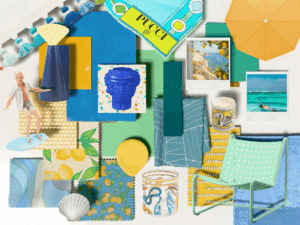This how-to guide will demonstrate how to render a window dressing.
How to render drawings – part 4 of 6
Rendering a window treatment
This next demonstration is going to show you how to add colour to a wall elevation with a window treatment. You will learn a range of techniques that will show you how to represent the reflection of glass, sheer fabrics, patterned fabrics and the different effects of wood, on the frame, curtain pole and skirting.
To prepare your drawing, firstly mask off either side of the curtains. When applying colour to this type of drawing start with the finishes that are furthest away. In this case we will start with the glass, blend a small amount of the blue, grey and pastel chalks to create a colour that will represent glass. Using a cotton wool ball or bud, apply a small amount to each section of the panes, allowing some of the white of the paper to show through.
Using a small amount of the putty rubber, drag this across a section of the window. This will help to lift off parts of the pastels to help give the effect of the glass reflection.
To represent the wooden window frame, I would suggest using a watercolour pencil as this will allow you to neatly apply the colour in small areas. This can then be blended using a fine, damp brush. Where the frame can be seen through the sheer fabric, this can be slightly lighter to give a more delicate effect.
The cream curtain pole has been distressed with touches of gold. To achieve this look, use acrylic paints. Firstly, start with white and then add a small amount of yellow, until you achieve the desired shade. You may need to use just a small amount of water to help blend these together. Once you are happy with the colour, take a fine, damp brush and start to apply this to the areas of the curtain pole, paying particular attention to the finials and the curtain rings.
Use the same technique shown earlier, to blend the desired shade of colour required for the sheer fabric. The sample of sheer fabric that we have chosen, has a subtle stripe running vertically down the full length. Don’t worry about trying to show this, instead, concentrate on applying a light application of the base colour all over the curtains as the details of the stripes will be lost in the folds and gathers of the curtains. Take a small amount of the putty rubber and use this to lift of some of the pastel colour to help reflect some of the transparency of the sheers.
The fabric that we have used for the main curtains, has a large white floral design with gold details. Don’t worry about trying to replicate the pattern exactly as the scale will appear much smaller and many of the details will be lost within the folds of the curtains. You are simply trying to show a representation of this design. Start by selecting a range of pastel chalks to create a suitable shade to represent the background of your fabric. Now this can be applied all over the curtains using a combination of the cotton wool balls and the cotton bud.
To protect your drawing and to help keep this clean, you may find it helpful to place a piece of A4 paper over the top. This will allow you to rest your hand on and avoid smudging any of your details. The pleats and folds can be defined using a watercolour pencil.
Pay attention to the areas where the curtains have been drawn back and held in place with the rope tiebacks. These lines can now be softened with a damp brush.
Now the pattern can be added. Start with adding the stems and the leaves, think about how the pattern repeat will be lost within the folds of the curtains, a watercolour pencil is ideal for this.
You may find it easier to use acrylic paints as this will stand out more from the background colour. Here, I have taken white and using a damp brush, mixed this with a small amount of yellow to create a soft cream colour to represent the flower. Look at where the details of where your stems and leaves have been added to your drawing and now start to apply the creamy white paint directly to the curtains. It’s a good idea to have a small amount of pure white as this can be used to add definition. Once the white has dried, you can now add a small amount of yellow, to represent the middle of the flower. The same yellow that was used for the middle of the flower can be used to represent the gold coloured tiebacks.
To finish off the drawing, a simple wash of colour can be added to the skirting and coving and pastel chalk can be blended to give the effect of a painted wall.
Now that you have an understanding of the basic rendering techniques, move on to the next video to see how to apply full colour to a furniture plan.

